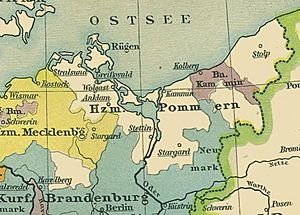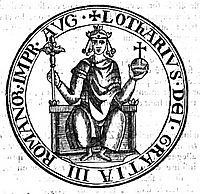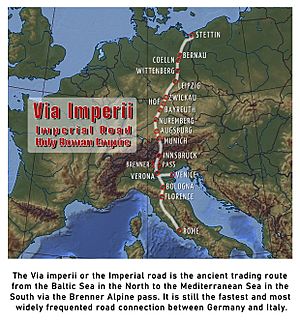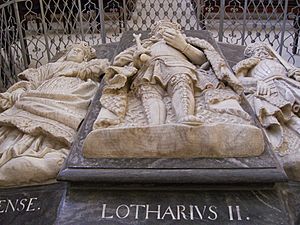Lothair III, Holy Roman Emperor facts for kids
Quick facts for kids Lothair III |
|
|---|---|

Portrait of Lothair in the Codex Eberhardi, Fulda monastery 1150/60
|
|
| Holy Roman Emperor | |
| Reign | 1133–1137 |
| Coronation | 4 June 1133, Rome |
| Predecessor | Henry V |
| Successor | Frederick I |
| King of Germany (formally King of the Romans) |
|
| Reign | 1125–1137 |
| Coronation | 13 September 1125, Aachen |
| Predecessor | Henry V |
| Successor | Conrad III |
| King of Italy | |
| Reign | 1125–1137 |
| Predecessor | Henry V |
| Successor | Conrad III |
| Duke of Saxony (in opposition to Otto) | |
| Reign | 1106–1137 |
| Predecessor | Magnus |
| Successor | Henry II |
| Born | before 9 June 1075 Lutterloh, Duchy of Saxony |
| Died | 4 December 1137 (aged 62) Breitenwang, Tyrol, Duchy of Bavaria |
| Burial | Königslutter |
| Spouse | Richenza of Northeim |
| Issue | Gertrude of Süpplingenburg |
| House | Supplinburg |
| Father | Gebhard of Supplinburg |
| Mother | Hedwig of Formbach |
| Religion | Catholicism |
Lothair III (born 1075 – died December 4, 1137) was a powerful ruler in Europe. He was known as Lothair of Supplinburg. He became the Holy Roman Emperor in 1133 and ruled until his death.
Before becoming emperor, Lothair was appointed Duke of Saxony in 1106. Later, in 1125, he was chosen as King of Germany. He was crowned emperor in Rome. Lothair was the son of a Saxon count named Gebhard of Supplinburg. His time as ruler was often challenging because of conflicts with the Hohenstaufen family, especially Duke Frederick II and Duke Conrad. Lothair died while returning from a successful military campaign against the Norman Kingdom of Sicily.
Contents
Becoming a Powerful Leader
Not much is known about Lothair's early life. We first see his name in records around 1088. His father, Gebhard of Supplinburg, was part of the Saxon Rebellion against the ruling Salian dynasty. Gebhard died in battle on June 9, 1075, fighting against Emperor Henry IV. Lothair was born shortly after his father's death. In 1100, he married Richenza of Northeim, who came from a wealthy family.
Lothair became very rich and powerful by buying land, inheriting property, and through his marriage. His marriage to Richenza made him the wealthiest noble in Saxony. He supported Henry V when Henry rebelled against his own father, Henry IV, in 1104. This rebellion led to Henry IV giving up his throne in 1105. Because of Lothair's loyalty, Henry V made him the Duke of Saxony in 1106. This happened after Duke Magnus of Billung died without children.
However, Lothair soon disagreed with King Henry V, who was becoming too strict. Lothair joined other nobles who opposed the king. He even acted on his own, giving land to Count Adolf of Schauenburg in 1111. Henry V temporarily removed Lothair as duke in 1112, but Lothair got his title back by making a deal with the king. In 1115, Lothair led the Saxon forces and defeated the emperor in the Battle of Welfesholz. This victory meant Henry V lost control over Saxony.
Lothair's Reign as King and Emperor
| German royal dynasties | |||
| Süpplingenburg dynasty | |||
| Chronology | |||
| Lothair III | 1125 – 1137 | ||
| Family | |||
| Family tree of the German monarchs |
|||
| Succession | |||
| Preceded by Salian dynasty |
Followed by House of Hohenstaufen |
||
When Emperor Henry V died in 1125, the leaders of Germany met to choose a new king. They did not choose Duke Frederick of Hohenstaufen because he was too proud and refused to accept a free election. Adalbert of Mainz suggested Lothair. Even though Lothair was over fifty and had no sons, he was chosen as King of Germany. This election was important because it showed that the nobles wanted to choose their king, not just inherit the position.
Lothair also faced challenges in Bohemia. After Duke Vladislaus I died in 1125, there was a fight over who would rule next. Lothair supported Otto II the Black, who had paid him a lot of money. Lothair's army went into Bohemia in 1126 but was defeated at the Battle of Chlumec. Even though Lothair lost the battle, the winner, Soběslav, still recognized Lothair as his king. This helped Lothair gain respect and power.
Fighting the Staufers
The Supplinburg family, Lothair's family, was a political rival of the Salian dynasty and the House of Hohenstaufen. Lothair had problems with Duke Frederick II of Hohenstaufen. Frederick refused to give Lothair property that Lothair believed belonged to the king. Lothair argued that these lands should now be imperial property since the Salian family had no direct heirs.
Fighting between Lothair and the Staufers began in 1125. Lothair tried to take the royal lands, which made the Staufers angry. Lothair then declared Frederick II an outlaw and took away his ducal title.
In 1127, Lothair's attack on the Staufers failed at Nuremberg. Because of this, the Swabians and Franconians chose Frederick's younger brother, Conrad, as an anti-king (a rival king). Conrad went to Italy in 1128 and was crowned King of Italy. Lothair used Conrad's absence to attack the Staufers again. In 1129, he captured the cities of Nuremberg and Speyer. Conrad failed to get support in Italy and returned in 1130, which was a partial victory for Lothair.
Policies in the Northeast
Lothair's actions in the northern and eastern parts of his kingdom had a lasting impact. Since he was from Saxony, he focused more on this area than previous rulers. He had already started shaping the region in 1111 by placing Count Adolf of Schauenburg in charge of Holstein and Stormarn.
Lothair also created the Landgraviate of Thuringia. This was a way to bring together different parts of the old Duchy of Thuringia. In 1131, he appointed Louis to rule this area, which led to stable rule for over a century.
In 1134, Lothair appointed Albert the Bear as Margrave of Brandenburg. In 1136, he gave Conrad the Great of Wettin the title of Margrave of Lusatia, combining two important border regions. He also asked the Pope to give more power to the Archbishops of Bremen and Magdeburg. In 1135, King Eric II of Denmark became an imperial prince, joining the German assembly. Lothair also successfully made peace between Poland and Bohemia/Hungary. This led to the Polish Duke Bolesław III Wrymouth paying tribute for the Duchy of Pomerania, which became a part of the Empire.
Working with the Pope
In 1130, there was a disagreement over who should be the new Pope. Some cardinals chose Innocent II, while others chose Anacletus II. Both claimed to be the rightful Pope. Anacletus gained control of Rome, forcing Innocent to flee to France. However, Innocent gained support from the kings of France and England, thanks to Bernard of Clairvaux.
Both Popes offered Lothair the imperial crown. Lothair was busy fighting the Staufers, but Bernard of Clairvaux convinced him to support Innocent II. In March 1131, Lothair met Innocent II in Liège. Lothair showed respect to the Pope and promised to help him against Anacletus and Roger II of Sicily. In return, Innocent II confirmed Lothair's rights as king. Innocent II then crowned Lothair King of the Romans again on March 29, 1131.
Lothair went to Rome with a small army because most of his soldiers were in Germany fighting the Staufers. Since Anacletus controlled St. Peter's, Lothair's imperial coronation took place in the Lateran Basilica on June 4, 1133.
Campaign Against Sicily
In 1135, Lothair finally defeated the Staufers with the help of Henry the Proud. At a meeting in Bamberg, the Staufer brothers were forgiven and got their titles back. Conrad gave up his claim to be king. The Staufers also promised to join Lothair's second military campaign in Italy.
In 1136, Lothair, now the undisputed ruler, set out with a large army. This campaign was successful. Roger II of Sicily tried to make peace. The campaign against Roger began because Innocent II and the Byzantine Emperor John II Comnenus wanted it. Two armies, one led by Lothair and the other by his son-in-law Henry the Proud, arrived in Italy. They captured Capua and Apulia from Roger. Innocent II claimed Apulia belonged to the Pope, so Lothair and the Pope agreed to give the duchy to Rainulf of Alife.
Lothair's troops became tired of fighting during the hot summer. Lothair had hoped to conquer all of Sicily, but he had to give up the campaign and return home.
Lothair's Death
On his way back, Lothair gave his son-in-law, Henry of Bavaria, the Margraviate of Tuscany and the Duchy of Saxony. He also gave him the imperial symbols, which some saw as a sign that Henry would be the next king. Lothair died on December 3, 1137, in Breitenwang. His body was prepared for the long journey, and his bones were taken to the church in Königslutter, which he had chosen as his burial place. A month later, Pope Anaclet II also died, ending the disagreement over who was the rightful Pope.
When Lothair's grave was opened in 1620, a sword and an imperial orb were found inside. Lothair built a magnificent church in Königslutter. His reign was important and showed strong leadership.
Family Life
The Supplinburg family line was short. Lothair and his wife, Richenza of Northeim, had only one child who survived, a daughter named Gertrude of Süpplingenburg, born in 1115. To gain support for his election as king, Lothair married Gertrude to Henry X, Duke of Bavaria, in 1127. Their only son was Henry the Lion.
After Lothair's death in 1137, the Hohenstaufen leader Conrad was chosen as King Conrad III. Henry the Proud, Lothair's son-in-law and heir, refused to accept the new king. Because of this, Conrad III took away all of Henry's lands.
See also
 In Spanish: Lotario II del Sacro Imperio Romano Germánico para niños
In Spanish: Lotario II del Sacro Imperio Romano Germánico para niños






